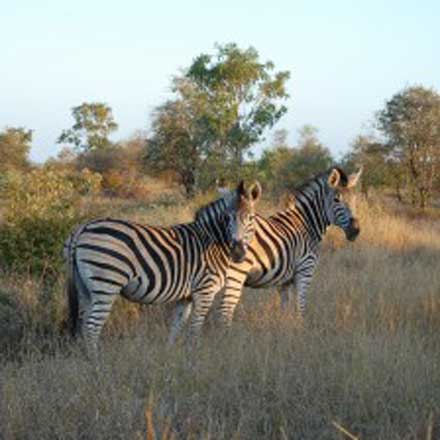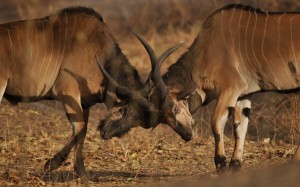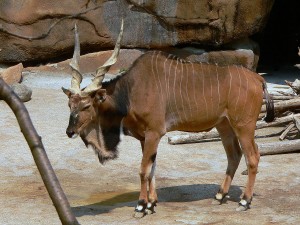
So far, my choices for a light and medium rifle- a .308 Steyr Scout and a .376 Steyr ProHunter- have proved to be excellent for the game I harvested. Truth be told, the .376 could have very easily handled everything, being adequate for even eland, while not too much with the lighter factory loads, for impala or warthog. But when my Zimbabwean friend Stephan called me, and asked me to come hunting in the fall of 2001, I knew just the rifle I also wanted to take on my hunt; a lever gun- no not a .30-30… nor a .444 or .45-70. I had just read in late 2000 about Wild West Guns in Anchorage, Alaska, converting .45-70 Marlins to shoot the similar length, but fatter .50 Alaskan, which fires .510 caliber bullets. Its performance on big game is exceptional, with either heavy lead or jacketed bullets, at what most would consider relatively “modest” velocities.
A quick call to them, and my Marlin .45-70 was on its way. I didn’t want a lot of fancy extras, asking them to cut the 22” barrel back to 20”, rebore it to .510, and do the minor action work to make the fatter round feed properly. A Pachmayr Decelerator pad was a must, as I could shoot bullets as heavy as 500 ~ 600 grains. While they tried to recommend porting in the muzzle, I refrained from having them do that, as while hunting, I never really notice recoil very much. Also, I didn’t want to make the gun any louder, especially in the field, when I may at times forget my hearing protection.
The .50 Alaskan is a rimmed case based on the .348 Winchester, blown out straight to accept a .510 caliber bullet. Note that factory brass is now available from Starline, due to its popularity. While the rim on the .348 is the same OD as a .45-70, the body diameter above the rim, is slightly larger, allowing it to handle .50 caliber bullets, while the .45-70 is limited to .458. It can push a 450-grain bullet to almost 2,000 fps, or a 525-grain flat point, hard cast to just over 1,800 fps. While these are top loads, they only produce around 35,000 psi, relatively modest by today’s cartridges in comparison. For fun, you can shoot lighter cast bullets in the 300 to 430 grain range, at the speed of a .22 long rifle, using around 35 grains of powder. Note that these very light loads, would still work great in the US, on deer or hogs.
...
Chapter 1: Feeding A .50
For this hunt, my primary soft point bullet- the 450-grain Barnes Original, jacketed flat point- was modified by adding a second cannelure. Using a Corbin hand cannelure tool, the additional one was placed about an eighth of an inch lower than the first, to create a longer round for better feeding. This would be used for medium-sized plains game. In case I got a chance to tackle something really big, I also worked up a load using the Cast Performance Bullets’ 525-grain WFN- or Wide Flat Nose. It’s a gas checked cast bullet, which can take more speed, than my shoulder can handle. Both bullets were loaded below top speeds, knowing they would still do the job. The 450 Barnes did almost 1,850 from my 20” barrel; the 525 broke 1,700 fps.

Also note that the 600-grain Barnes Original, meant for the .500 Nitro double, was capable of just over 1,600 with this massive slug, but at that relatively low speed, expansion wouldn’t be possible.
For fun, as I’m sure the folks in Zimbabwe had never seen a lever gun, much less a .50 caliber one, I also brought just one special cartridge, for “Show and Tell” time in the field. I grabbed a .50 BMG API bullet, originally meant for shooting down planes; API stands for: armor piercing incendiary. They have a hardened core for penetration, and an explosive charge that detonates on impacts. Pretty cool! Weighing around 650 grains, 35 grains of a medium burning powder pushed them to about the same speed as a 12 gauge shotgun slug. Recoil really was not that bad, at least for only one shot. Long and pointy, they could only be loaded singly, directly into the chamber. As I found at home on the shooting range… if I change my mind, and don’t want to fire them once loaded, I had to pull the lever and bolt out of my rifle, to get the loaded round out of the gun! Later you’ll learn just how well these went over in Africa.
Initially back home, when sighting in my two hunting loads, it appeared I was going to have a bit of a problem. Big bore rifles tend to throw heavy bullets, of different weights, to varying...
points of impact. My hunting load with the 450 Barnes, was shooting about six-inches higher, than the 525-grain heavy cast load. Staring downrange at my target, through my Leupold 1.5-6 scope, with an illuminated German #4 reticle, I found that the 450’s struck to the point of aim, while the 525-grainers were hitting at the top point, of the lower thick post. Both of these loads were consistently shooting into 1-1/2” at 100 yards. As long as I didn’t mix loads in the magazine, this proved to be no handicap when hunting. While carrying the 450s, I would aim using the center of my crosshair. If after bigger game with the 525s, I just made a mental note to aim with the top of the thick, bottom post.
Chapter 2: Barnes 450 Original
Upon arrival at camp, the first thing I did was check the zero of all three rifles. None had been affected by the trip over, and were all shooting just a little high at 100 yards, same as they had done in New Mexico. Over the course of the seven days of hunting, normally I would bring all three rifles, leaving one cased inside the Land Cruiser. My chosen rifle for the day would be carried, and the third one would be lashed to the roll bar, in the back of the bed, just behind the cab. Whenever the trackers handled any of my rifles, they always did it with great care and respect, as if it was their own personal gun.
On the second day of the hunt, I had a chance at a management eland bull, at right around 150 yards. Resting off a small tree, I fired for the center of his chest, as he faced me head on. Being a .50 caliber, 450 grain bullet, we heard a distinct WHUMP of the huge slug strike, and went to collect my trophy, after he then turned and ran. No blood could be found anywhere, even though we could see in the dirt, where he had taken off hard, turning to run. Not to worry, we’ll just follow his tracks and start to find a blood trail; but none was ever found. Everyone in our party had thought it had been a solid hit… perhaps we were all wrong though.
The two trackers, who were so good at their job it was scary, tracked the bull for over an hour, but never found a drop of blood. They also noted, that his tracks did not indicate he was in any stress, or impaired in any way. I had a very steady rest, and was confident of the shot- could I have cleanly missed? After lunch break back in camp, my PH suggested we verify the zero again, as perhaps it...
might have changed. A fresh target is posted at 100 yards, and I take steady aim off sandbags. After three shots, we walk down, only to find a nice inch-and-a half group at 3 o’clock, fully six inches to the right!
He had not bled through the entry hole, but apparently gotten away, only to die later.
So at 150 yards, my bullet would have gone nine inches off center, most likely cleanly missing the bull… most likely. Sadly though, four days later, when traveling in the same general area where that shot had been taken, we came across the body of the bull. My bullet had struck between the rib cage and the left shoulder, and slipped back under the skin to the abdomen. He had not bled through the entry hole, but apparently gotten away, only to die later. It was very sad, for besides the suffering he had endured; his massive carcass had gone to waste. Nonetheless, it still counted as an animal I had taken, and was added to my running tab, as it should.
The following day, the first animal taken with the .50 Alaskan was a younger eland bull, which weighed about 700 lbs. A broadside shot was placed just behind the left front leg, at a measured 124 yards. The animal jumped straight up, wheeled around, and disappeared behind some brush. We quickly found him, just 54 yards from where the shot had been taken. A bulge in the hide on the far right side, confirmed that the 450 Barnes had performed as designed. It broke a rib going in, wrecked both lungs, and broke a rib on the far side, stopping under the hide. Retaining 428 of its original 450-grains (or 95%), it had incredibly expanded to 7/8ths of an inch in diameter!
Two days later, again using the Barnes Original, a wildebeest of around 450 lbs., was taken with a broadside shot at 112 yards. Bucking hard upon receipt of the bullet, the bull barely made it 34 paces from where he was shot. While dressing the animal, the bullet was again found in the far side, between two ribs, having broken a rib on entry. This time the bullet was picture-perfect, had expanded to 1 inch, and still retained 99% of its original weight (or 446-grains) – incredible performance to be sure.
From the taking of these two relatively large animals, I believe this bullet works well on medium to light-heavy game, making certain you take only broadside shots. If you anticipate hunting in heavy brush, or where shots may have...
to angle through more of the animal, and wanted to stay with a 450-grain bullet, I’d recommend a thicker jacketed bullet, with less extreme expansion.
Chapter 3: Special Load
On the fourth or fifth day of hunting, I thought it would be good to show the safari owner Rob, and my PH Paul, what the .50 could do with a military surplus bullet. We were out in a fairly open grassland area, with HUGE koppie rocks of granite, from the size of a car, to bigger than a four-car garage, randomly located here and there. Sometimes you can find several smaller ones piled on top of a massive one below. About 500 yards from where we were having lunch, was a koppie at least 50 feet tall, and at least twice that wide; a smooth granite monolith in the grass. I stood up, and pulled the almost 4” long API round from my pocket, not telling them what it was, only saying I wanted to fire a “special” load I had brought along.
Aiming at the huge rock, I told them to cover their ears with their hands, but the moment they hear the shot, take their hands away. They had no idea what to expect. Holding about four feet high to allow for drop, I fire the API at the rounded face. A brief instant later, the .50 BMG bullet, meant for shooting down planes in World War II, slams into the rock face and detonates, with a bright flash. A thunderclap bounces back to our ears, as a huge dense cloud of white smoke, drifts slowly off to the right.
“WOW! What was THAT?” everyone calls out to me.
“In World War II, our fighter planes used to shoot those at the enemy’s planes, trucks and light vehicles. For being almost sixty years old, they still work pretty well, eh?”
It was the hit of the day, actually the whole week, and each of them asked if they could also shoot one of those themselves. I was sorry, but I told them that… being as I was not too sure about even bringing one to Africa, I couldn’t risk bringing a dozen, so that one display would just have to do for now.
Chapter 4: Big Bullet, Big Bull

An excellent bullet for heavier game, or where greater penetration than the Barnes...
450 is required, would be the Cast Performance Bullet 525-grain, gas checked, hard-cast WFN (for Wide Flat Nose). The meplat on this bullet (that’s the flat point of the nose) measures a full .410”. The impact it has on large game has to be seen, for you to truly appreciate it. The final animal was taken with this bullet, towards the end of my safari. I was looking for a truly big eland bull, one that would look awesome mounted on the wall. The landowner told me of a bull that they simply called “the BIG ONE”.
We hunted all morning looking for him, towards the end of my trip. Late in the morning, the tracker pointed across the valley and said, “There he is!”
Though we were about a mile from the bull, even at that distance you could tell he was huge. We circled around, and headed for him from downwind. About a half-hour later, as we eased through the brush, we came upon him standing under a large gum tree. Talk about shooting pressure! The landowner was watching me prepare to shoot, as well as his son, the PH, two trackers, and my good friend Stephan. The eland was facing us, almost directly on, at about 75 yards, but quartering slightly to the right.
Everyone encouraged me to take a rest, with my big .50, on the tree before us. However, I knew that the gun would recoil up and break branches, kicking debris into my face, and keeping me from getting off another shot. As I took aim at the point of the right front shoulder, I decided to step to the side, away from the tree, to stand out in the open. At the very same moment the eland spotted me, the 525-grain bullet was already on its way.
The bull reacted violently to the impact, then turned to the left, and tried to run away. I quickly levered in another round, and made a perfect broadside shot, just behind his left front leg. The second shot caught him before he had made it 15 feet… he went down before he was able to cover another 15.
All of the locals around me were shouting in excitement. The landowner said that he had never seen a big eland go down so fast like that. “You cannot just turn off an animal that weighs almost a ton, especially if the nervous system is not hit!” Examining the bull (and the post-mortem in the butchery) showed how the two shots had gone.
The first shot at 74 yards, clipped the right front shoulder blade, leaving a half-moon, .50-caliber cutout in the front edge. The...
bullet then diagonaled through two ribs, the front lobe of the right lung, cut the 1-1/4” diameter aorta off of the top of the heart, continued on through the lungs, liver, and stomach… exiting just in front of the left hip. We measured the penetration at well over six-feet! The second shot taken at the running bull, was just behind the left front leg, exiting at almost the exact same spot on the right side, breaking a rib going in and out.
All of the locals around me were shouting in excitement.
Field-dressed, less hide, head and legs, on a certified butcher’s scale, the carcass alone weighed 823 lbs., putting the live weight at around 1,650 lbs. As an eland gets older, a distinctive tuft of hair on his forehead grows and becomes bushier over time. On this eland, it looked like two 6” paint brushes, had been mashed and glued to his forehead.
In a short time, a Toyota mini pickup showed up with about a dozen locals in the back, to haul the bull off to the butchery. I asked the PH how in the world they were ever going to get the bull into that little truck; how could they possible lift it into the bed? “Watch and you will see”, he told me. So they backed the little truck up to about 3 feet from the tail end of the huge bull. Then working all together with six on a side, amazingly they stood the bull up on his rear, and then let him topple over into the bed- no lifting required! Note that in Zimbabwe, they do not field dress game as we do in the US. Animals are brought back whole, so all of the entrails can be saved and eaten- nothing goes to waste, in a land where meat is so hard to come by for the natives.
If you truly need a BIG BORE rifle, or you just have to have one, I can heartily recommend the .50 Alaskan. It sure made a big impression on the game, and the people, in Zimbabwe. The trackers and my PH were singing praises of the Alaskan from the time I first shot it, until I finally took the big eland bull.
As the landowner said when I left, “You could certainly take a Cape buffalo with that .50 Alaskan, using those heavy cast bullets… and be confident about doing so!”